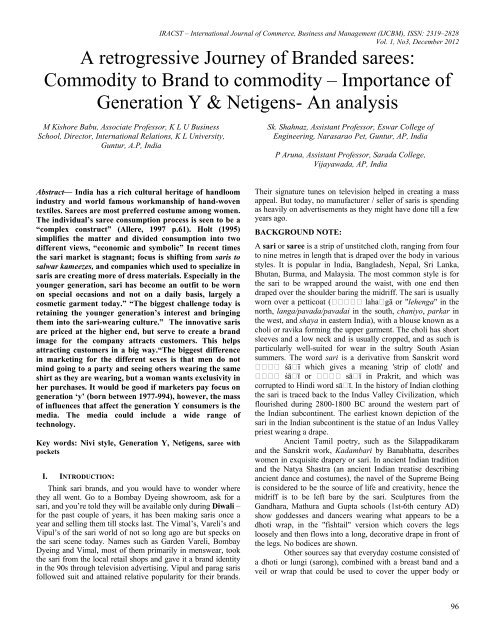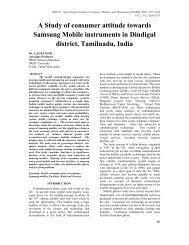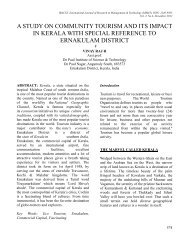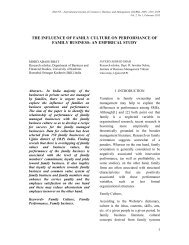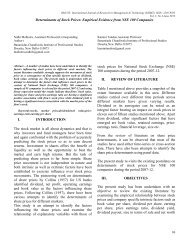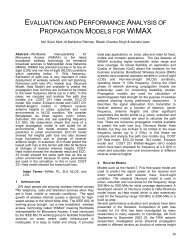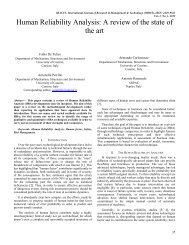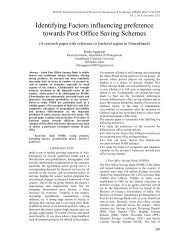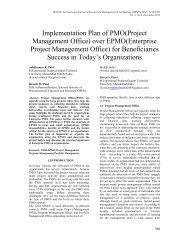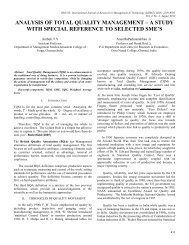A retrogressive Journey of Branded sarees: Commodity to Brand to ...
A retrogressive Journey of Branded sarees: Commodity to Brand to ...
A retrogressive Journey of Branded sarees: Commodity to Brand to ...
Create successful ePaper yourself
Turn your PDF publications into a flip-book with our unique Google optimized e-Paper software.
Modern Style <strong>of</strong> DrapingDue <strong>to</strong> migration <strong>to</strong> different Western countries likeSouth Africa etc., many Indian women began <strong>to</strong> wear thenormal sari below the waistline exposing the navel which isknown as Low-rise sari or low hip sari. Also due <strong>to</strong>liberalization and changing global markets, saris arereemerging as an erotic wrap which can expose as much as itconceals. As a result, saris began <strong>to</strong> be designed in manyinnovative ways and different materials. Transparent & semitransparentsaris made <strong>of</strong> sheer fabrics like chiffon etc., is onesuch example.Pre-stitched or au<strong>to</strong>matic SarisPre-stitched <strong>sarees</strong> is an au<strong>to</strong>matic saree makes sareewearing a one step easy process. These <strong>sarees</strong> are draped insuch a easy way, just like putting on a skirt. Its a skirt withstitched saree pleats at the centre worn over a petticoat withoutthe fuss or row <strong>of</strong> tucking, pleating, and adjusting the pallavlength as they are already set in the centre <strong>to</strong> make you feelmore comfortable and easy in wearing it . Pre-stitched sari ismore <strong>of</strong>ten famous in younger age group. They look gorgeouswith fendi bags and saree. Its a new fashion statement foryoungsters! Petticoat is worn separately and it is not stitchedwith saree. This easy <strong>to</strong> wear, pre-stitched saree can be wornby anybody without the bother <strong>of</strong> actually draping it.These saris are tied in different ways such as petticoatbeing tied at about 4-6 inches below the navel and just abovethe pubic area, or where the blouse is small which ends justbelow the Breasts and the pallu is thin thereby exposing thesome part <strong>of</strong> the blouse and almost the entire midriff. Thesewere made popular by the celebrities <strong>of</strong> Bollywood industryand other popular regional film industries like Tamil cinemaand Telugu cinema. These are mainly worn by the rich andeducated upper class women who consider navel exposure as afashion. But wearing the sari below the navel doesn't alwaysrefer <strong>to</strong> exposing the navel. Sometimes the navel is coveredwith the pallu in a low-rise sari also. In some Corporates inIndia, saris are required <strong>to</strong> be worn in an elegant manneravoiding navel exposure.Literature Review:India has a rich cultural heritage <strong>of</strong> handloomindustry and world famous workmanship <strong>of</strong> hand-woventextiles. The processing and manufacturing <strong>of</strong> textiles was thesecond largest occupation <strong>of</strong> India after agriculture.Fascinating motifs and super design <strong>of</strong> the fabric assignedspecial importance <strong>to</strong> the sec<strong>to</strong>r. India has the largesthandlooms industry in the world. The handloom sec<strong>to</strong>r, with along tradition <strong>of</strong> excellence in craftsmanship, not only plays animportant role in preserving the country's heritage and culture,it also makes a major contribution <strong>to</strong> the economy. About 65lakh persons are engaged in weaving and associated activities.There are 32,88,556 household looms, and 1,97,752 nonhouseholdlooms as per Textile: Resurgence published byMinistry <strong>of</strong> Textiles (2009-10)IRACST – International Journal <strong>of</strong> Commerce, Business and Management (IJCBM), ISSN: 2319–2828Vol. 1, No3, December 2012The individual’s saree consumption process is seen <strong>to</strong>be a “complex construct” (Allere, 1997 p.61). Holt (1995)simplifies the matter and divided consumption in<strong>to</strong> twodifferent views, “economic and symbolic”. Firstly, in relation<strong>to</strong> economics, Holts (1995, p.1) suggests, “products provideparticular benefits”. Secondly, in relation <strong>to</strong> symbolic he statedthat products are “conceived as vessels <strong>of</strong> meaning that signifysimilarly across all consumers”. Further, Alleres (1997, p.53)explains that through the consumption process as resulting inpurchasing products depends on three fac<strong>to</strong>rs: culture, income,and the exposure <strong>to</strong> information.Culture affects human behaviour in many ways(Craig & Douglas, 2006). However the impact <strong>of</strong> culture andhow <strong>to</strong> determine culture is difficult <strong>to</strong> understand because <strong>of</strong>its bond <strong>to</strong> all facets <strong>of</strong> human existence. According <strong>to</strong>Usunier and Lee (2005) culture has evolved as social,political, economical, and technology has reshaped the culturallandscape. Since there has been a considerable change andincrease in technology, expanding networks, and masscommunication, it has caused an alteration in culturalboundaries (Hermans and Kempen, 1998), and linkagesbetween cultural individuals. Additionally, as individualmembers <strong>of</strong> cultural groupings migrate from one country <strong>to</strong>another it causes an even more obscure vision <strong>of</strong> culturalboundaries. This is because when individuals migrate andbond with others they bring their values, behaviour, andinterest with them, which are interchanged. It is alsoconsidered that a large extent in consumers purchasing isdependent on their income. Dubois & Duquesne (1993) notethat income is seen as a fac<strong>to</strong>r that constraints individuals inpleasing their consumption needs. Additionally, one <strong>of</strong> thereasons that many people is constraint <strong>to</strong> purchase luxurygoods are because luxury goods are produced <strong>to</strong> initially targetupper class clienteles.During the early years, luxury products wereconsidered a privilege <strong>to</strong> possess. As explained by Nueno andQuelch (1998) the word “luxury” was applied <strong>to</strong> products thatwere rare and scarce which were only presented <strong>to</strong> minorindividuals. However, since time has changed and the Sareemarket has grown considerably, saree has been moreaffordable for middle class consumers. Individuals areinfluenced according <strong>to</strong> the important events and moments tha<strong>to</strong>ccur in their lifetime (Meredith and Schewe, 1994; Ryder,1965). These moments and events may include war, economy,superstars, icons and technology that influence individual’sperceptions and values. Additionally, the significant influencethat individuals will recall occurs between their adolescent andearly adulthood years that they will never forget for the rest <strong>of</strong>their lives (Schuman & Scott, 1989). From the perspective <strong>of</strong>marketers, in targeting individual’s desires is a part <strong>of</strong> avaluable technique (Noble & Schewe, 2003).Individuals influence from moments and events,should be taken in<strong>to</strong> consideration in developing personal careproducts. consumers in Asia and India in particular havebecome wealthier, accepting Western style culture as a part <strong>of</strong>a growth in economics (Debnam & Svinos, 2006). Affecting a98
IRACST – International Journal <strong>of</strong> Commerce, Business and Management (IJCBM), ISSN: 2319–2828Vol. 1, No3, December 2012vast amount <strong>of</strong> previous research, individual’s preferencesRecognising this challenge, the Chennai – basedplay a key role in purchasing luxury goods as well as culture. RMKV is innovating, making denim saris, reversible ones andIndividual’s preferences may be based on desire and nondesires,saris with pockets in them. “The biggest challenge <strong>to</strong>day iswhich are based on experience in purchasing luxury retaining the younger generation’s interest and bringing themitems from their satisfaction, or non-desire such as bias in<strong>to</strong> the sari-wearing culture.” The innovative saris are priced<strong>to</strong>wards brand products (Anurit et al., 1999). Different age at the higher end, but serve <strong>to</strong> create a brand image for thegroups may view luxury items differently. Mature age groups company attracts cus<strong>to</strong>mers. This helps attracting cus<strong>to</strong>mers inmay view luxury products differently in comparison with a big way. The biggest difference in marketing for the<strong>to</strong>day’s teenagers, due <strong>to</strong> the effect <strong>of</strong> technology that the different sexes is that men do not mind going <strong>to</strong> a party andprevious generation did not have (Hauck & Stanforth, 2007). seeing others wearing the same shirt as they are wearing, but awoman wants exclusivity in her purchases.High time <strong>to</strong> redefine marketing strategies for <strong>sarees</strong> inIndian Terri<strong>to</strong>ryWith the well – known tagline <strong>of</strong> “A woman expressesherself in many ways, Vimal is one <strong>of</strong> them,” the Reliancegroup’s Vimal shown on the sari scene. “The Reliance groupcompany, once a leading player in the branded sari market, isre-launching itself as a complete family brand by next yearand saris will be a part <strong>of</strong> its portfolio for Indian wear.”Garden Vareli invested heavily in marketing its saris duringthe mid- ‘90s when it became synonymous with the mostpopular Indian fashion wear brand. But <strong>to</strong>day, even as itcomes up with innovative designs once in a while, its focus ison backward integration.The sari market is stagnant; focus is shifting from saris <strong>to</strong>salwar kameezes, and companies which used <strong>to</strong> specialize insaris are creating more <strong>of</strong> dress materials. Like her, for manyin India, especially in the younger generation, sari has becomean outfit <strong>to</strong> be worn on special occasions and not on a dailybasis, largely a cosmetic garment <strong>to</strong>day.”Top 20 Saree brands in India1. Satya Paul2. Kalyan Group3. Kuthampully Saree4. Divya Parameshwaran5. Sirumugai6. Karishma Kotak7. RmKV8. Dharmavaram, Anantapur9. Sari10. Mandira Bedi11. Rajampet12. Sonepuri Sari13. Tamil Nadu14. Nouva Monika Wahlgren15. Kanchivaram16. Rajahmundry17. Arvind Mills18. Bellary19. Economy <strong>of</strong> Tamil Nadu20. Sabyasachi MukherjeeInnovation can be order <strong>of</strong> the day:Nevertheless, companies are trying <strong>to</strong> create a brandfor saris, like the pioneer group with Hakoba, <strong>of</strong>fering a widerange <strong>of</strong> Indian and Western women’s-wear in traditionalwork such as chikankari and kantha, saris contribute <strong>to</strong> 33 percent <strong>of</strong> Hakoba’s revenues. Nevertheless, there is a market forbranded saris among older women in the smaller cities and<strong>to</strong>wns <strong>of</strong> the country.RmKV is a very old and popular s<strong>to</strong>re for silk <strong>sarees</strong> inChennai. There are few other good silk saree s<strong>to</strong>res in Chennailike Nalli, Kumaran Silks, The Chennai Silks etc. They allhave very good collection on silk <strong>sarees</strong> and other <strong>sarees</strong>.When come <strong>to</strong> shopping online on that s<strong>to</strong>res, RmKV, NalliThe Chennai Silks have online s<strong>to</strong>res, whereas online s<strong>to</strong>re<strong>of</strong> Kumaran Silks is under construction since years. RmKVand The Chennai Silks also have chudiar and dress materialsfor women, apparels for men and kids, whereas Nalli onlines<strong>to</strong>re has only collection <strong>of</strong> <strong>sarees</strong>. RmKV do not have onlysilk <strong>sarees</strong> there, they have Traditional Silks, EmbroideredSilks, 9-yard Silks, Theme Silks, Embroidered Fancy, PrintedSilks, Mysore Silks, Arangaetram Collection, NaturalSilks, Casual Sarees, Tasar, Georgette, Raw Silk, Cot-Silk etc.Similarly The Chennai Silks have different collections otherthan silk <strong>sarees</strong>. Whereas Nalli online s<strong>to</strong>re have Bridalcollection, New collections, Casual collections and Nalli Nextcollections.Generation Y & Netigens could be Hot but<strong>to</strong>n <strong>to</strong> makeSaree acceptable:Horovitz, (2002) describes that generation Y (bornbetween 1977-1994) are individuals that have a free spendingspirit and consist <strong>of</strong> 71 million 8 <strong>to</strong> 25 year olds. Althoughthere are a mass amount <strong>of</strong> generation Y consumers, thewealthiest group <strong>of</strong> people is between the ages <strong>of</strong> 19 <strong>to</strong> 25 yearolds who are either employed in full time jobs or part timework. Those who are either part time or at full time work arecollege students (Martin & Turley, 2004). Students <strong>of</strong>ten takeup part time work <strong>to</strong> find extra funding for their excessivespending. Usually students who work full time are employedduring the university holidays or breaks. Additionally, theseyoung consumers tend <strong>to</strong> be familiar with credit cards andtechnology (Weiss, 2003). This is consistent with a studyconducted by Kara et al., (1994) stated that there has been aconstant rise <strong>of</strong> accessibility <strong>of</strong> credit cards <strong>to</strong> target youngadult market since 1980’s. Likewise, retailers have createdtheir own s<strong>to</strong>re card <strong>of</strong>fering interest-free period. Moreover,99
the government in some countries attracts indebtedness, suchas in the UK, through the availability <strong>of</strong> student loans. Theaccessibility <strong>of</strong> credit card is known as a contribu<strong>to</strong>ry elementin the trading-up and overspending constructs (Bakewell &Mitchell, 2003). However, the mass <strong>of</strong> influences that affectthe generation Y consumers is the media. The media couldinclude a wide range <strong>of</strong> technology.Marketers are the major people who contribute <strong>to</strong> thematter <strong>of</strong> influencing consumer behaviour through theknowledge <strong>of</strong> fashion. The reason is that teenagers areconcerned about fashion value more than any other age groups(Koester and May, 1985). The media, which include theinternet, mobile phones, and satellite television are sometechnology that generation Y consumers value (Meredith andSchewe, 2002). The valuation <strong>of</strong> technology such as televisionhas affected viewers in relation <strong>to</strong> materialism amongadolescents, and the duration <strong>of</strong> viewing televisionprogrammes consists <strong>of</strong> seven hours a day (Nielsen, 1995).Individuals are affected by television, and the possibility isthat the more viewers consume television it is more likely thatthey will reflect their perceptions in “reality” as they have seenin television world.Additionally, O’Guinn and Shrum (1997); Wells andAnderson (1996) stated that what is televised in association <strong>to</strong>characters and materials represent the more affluent wellbeings.Wysocki (1997) explains that there has been anincrease in addiction <strong>to</strong> technology such as MTV (musictelevision) and internet chat rooms that homogeniseindividuals preference and attitudes. As there is an increase inhomogenisation and technology such as MTV and internetchat rooms is distributed worldwide, it has created greatsimilarity between teens in different nations than older peoplein the same country (Anderson and Hee, 1998). Suchhomogenisation has created global teen values, expressingindependence, self expression, openness <strong>to</strong> new ideas, andteen cultural values (Meredith and Schewe, 2002). Theconcept <strong>of</strong> global teen values could attract marketers <strong>to</strong> targetthe teen industry with luxury and expensive products. Forexample, commercializing on MTV and shows that wouldattract consumers <strong>to</strong> buy luxury products that are associatedwith celebrities and heroes. The effect would causestandardisation in product consumption hence MTV istelevised worldwide and the same message would be putacross so that all teens would have the same desire across theworld. In order <strong>to</strong> understand the generation Y consumers, it isalso important <strong>to</strong> consider fac<strong>to</strong>rs that motivate theseindividuals <strong>to</strong>wards the purchasing <strong>of</strong> luxury goods.Individuals view the word “luxury” differently depending ontheir socioeconomic background. In the marketing context,consumers view the meaning <strong>of</strong> luxury goods through eitherpeople’s interaction such as aspired and/or peer referencegroup, or object property such as product quality and hedonicvalue. Luxury consumer’s behaviour has motivatedparticularly in sociability and self-expression (Vigneron &Johnson, 1999).IRACST – International Journal <strong>of</strong> Commerce, Business and Management (IJCBM), ISSN: 2319–2828Vol. 1, No3, December 2012Leibenstein (1950, p.188) classified demand <strong>of</strong> goodsand services consumption in relevant <strong>to</strong> motivation in<strong>to</strong> twomain aspects: functional and non- functional. Functionaldemand is “demand for a commodity which is due <strong>to</strong> thequalities inherent in the commodity itself”. On the contrary,demand <strong>of</strong> goods consumption that comes from other fac<strong>to</strong>rs,which is not the product quality, is defined non-functionaldemand. Additionally, Leibenstein (1950) suggests thatexternal effects on values are the most important nonfunctionaldemand. This can be further explained by twosituations. Firstly, the product has increased or decreased due<strong>to</strong> the quantity <strong>of</strong> consumers purchasing the same products,and secondly the product has a higher value.Conclusion:All said and done, <strong>of</strong>fering exclusivity and a rationalprice is something <strong>of</strong> a pipedream <strong>to</strong> saree marketers. Tillthen, women who desire saris must adjust <strong>to</strong> the idea <strong>of</strong> clonesor making a drastic shift from saris <strong>to</strong> salwar kameezes orwestern wear. Marketer must enhance Competitive Advantagethrough Ingredient <strong>Brand</strong>ing and <strong>Brand</strong> Ecosystem strategyusing its high quality cot<strong>to</strong>n <strong>to</strong> differentiate its cot<strong>to</strong>n andtextile products in the marketplace, and also <strong>to</strong> improve itscompetitive position in India and there by rejuvenate thebranded <strong>sarees</strong> among Indian population.REFERENCES1. Alkazi, Roshan (1983) "Ancient Indian costume", ArtHeritage; Ghurye (1951) "Indian costume", Popular bookdepot (Bombay); Boulanger, Chantal; (1997)2. Costumes <strong>of</strong> India and Pakistan: a his<strong>to</strong>rical and culturalstudy - Shiv Nath Dar - 19693. R. S. McGregor, ed (1997). The Oxford Hindi-EnglishDictionary. Oxford University Press. p. 1003.ISBN 9780198643395.4. Monier-Williams, Monier (1995). A Sanskrit-EnglishDictionary. Delhi: Motilal Banarsidass. p. 1063.ISBN 81-208-0065-6. http://www.sanskrit-lexicon.unikoeln.de/monier/index.html.Retrieved 2010-07-04.5. Kapoor, Subodh (2002). The Indian encyclopaedia:biographical, his<strong>to</strong>rical, religious, administrative,ethnological, commercial and scientific. Reunion-SatyaYauvana, Volume 20. Genesis Publishing Pvt Ltd.p. 6422 (pg no. starts from 6130).ISBN 9788177552577.http://books.google.co.in/books?id=Ieypjy0k2TsC&pg=PA6422. "The etymology <strong>of</strong> the word sari is from theSanskrit 'sati', which means strip <strong>of</strong> cloth. This evolvedin<strong>to</strong> the Prakriti 'sadi', and was later anglicised in<strong>to</strong> sari"6. Parthasarathy, R. (1993). The Tale <strong>of</strong> an Anklet: An Epic<strong>of</strong> South India – The Cilappatikaram <strong>of</strong> Ilanko Atikal,Translations from the Asian Classics. New York:Columbia Univ. Press. ISBN 0231078498.7. Bharata (1967). The Natyashastra [Dramaturgy], 2 vols.,2nd. ed. Trans. by Manomohan Ghosh. Calcutta:Manisha Granthalaya; Beck, Brenda (1976). "TheSymbolic Merger <strong>of</strong> Body, Space, and Cosmos in Hindu100
Tamil Nadu". Contributions <strong>to</strong> Indian Sociology 10 (2):213–243. doi:10.1177/006996677601000202.8. Alkazi, Roshan (1983) "Ancient Indian costume", ArtHeritage9. Miller, Daniel & Banerjee, Mukulika; (2004) "The Sari",Lustre press / Roli books; Boulanger, C (1997) Saris: AnIllustrated Guide <strong>to</strong> the Indian Art <strong>of</strong> Draping, ShaktiPress International, New York. ISBN 0-9661496-1-0 ;Ghurye (1951) "Indian costume", Popular book depot(Bombay);10. Ghurye (1951) "Indian costume", Popular book depot(Bombay); Boulanger, Chantal; (1997) Saris: AnIllustrated Guide <strong>to</strong> the Indian Art <strong>of</strong> Draping, ShaktiPress International, New York.11. Boulanger, Chantal; (1997) Saris: An Illustrated Guide<strong>to</strong> the Indian Art <strong>of</strong> Draping, Shakti Press International,New York.12. Larsen, Karin (1998). Faces <strong>of</strong> Goa: a journey throughthe his<strong>to</strong>ry and cultural revolution <strong>of</strong> Goa and othercommunities influenced by the Portuguese. GyanBooks,. pp. 507 pages(see page 101). ISBN 8121205840,9788121205849.13. Dongerkerry, Kamala, S. (1959) The Indian sari. NewDelhi.14. Miller, Daniel & Banerjee, Mukulika; (2004) "The Sari",Lustre press / Roli books.15. Anderson, p. & Hee, X. (1998), “Price influence <strong>of</strong> agesegments <strong>of</strong> Beijing consumers”, Journal <strong>of</strong> consumerMarketing, Vol. 15 No.2, pp. 152-169.16. Bakewell, C. & Mitchell, W.V. (2003), “Generation Yfemale consumer decision- making styles”, InternationalJournal <strong>of</strong> Retail & Distribution Management, Vol. 31No. 2, pp. 95-106.17. Berry, C.J. (1994), The Idea <strong>of</strong> Luxury: A Conceptualand His<strong>to</strong>rical Investigation,18. New York: Cambridge University Press.19. Alleres, D. (1997), Luxery Product strategies marketing,Economica, Paris (2 eds.).20. Holt, D. B. (1995), “How consumers consme: Atypology <strong>of</strong> consumption practices”, Journal <strong>of</strong>Consumer Research, Vol. 22 (June), pp. 1-16.21. Leibenstein, H. (1950), “Bandwagon, Snob, and VeblenEffects in the Theory <strong>of</strong> Consumers’ Demand”, TheQuarterly Journal <strong>of</strong> Economics, Vol. 64, No. 2. (May),pp. 183-207.22. Meredith, G. & Schewe, C.D. (1994), “The power <strong>of</strong>cohorts”, American Demographics, Vol. 16 No. 12, pp.22-28.IRACST – International Journal <strong>of</strong> Commerce, Business and Management (IJCBM), ISSN: 2319–2828Vol. 1, No3, December 201223. Meredith, G.E. & Schewe, C.D. (2002), DefiningMarkets, Defining Moments: America’s SevenGenerational Cohorts, Their Shared Experiences, andWhy Businesses Should Care, No. 7, John Wiley &Sons, New York, NY.24. Miller, J. G. (1984). Culture and the development <strong>of</strong>everyday social explanation. Journal <strong>of</strong> Personality andSocial Psychology, 46(5), 961–978. Nielsen, A.C.(1995), Nielsen Report on Television, A.C. Nielson Co.,Northbrook, IL.25. Noble, S.M. & Schewe, C.D. (2003), “Cohortsegmentation: an exploration <strong>of</strong> its validity”, Journal <strong>of</strong>Business research, Vol. 56 No. 12, pp. 979-987.26. Weiss, M. (2003), “To be about <strong>to</strong> be”, AmericanDemographics, September, pp. 29- 36.27. Wells, W.D. & Anderson, C.L. (1996), “Fictionalmaterialism”, in Corfman, K.P and Lynch, J.G. Jr (Eds),Advances in Consumer Research, Vol. 23, Associationfor Consumer Research, Provo UT, pp. 120-126.28. Wysocki, B. (1997), “The global mall: in developingnations, many youths splurge, mainly on US goods- flushwith cash and plastic, they load up on Levi’s and tune in<strong>to</strong> MTV –a lot <strong>of</strong> ‘Little Emperors’, The Wall StreetJournal, (Eastern edition), 26 June, pp. A1.29. www.wikipedia.com/saree/1. M Kishore Babu, working as Associate Pr<strong>of</strong>essor, K L UBusiness School, K L University, Guntur. As a Direc<strong>to</strong>r,International Relations in K L University initiated many globalalliances, has got 17 years <strong>of</strong> experience, Published Threebooks, Guided 4 M. Phil. Scholars, published 32 papers,Organised 92 work-shops independently across India asresource person for Corporates, Non-pr<strong>of</strong>it organisations, S<strong>of</strong>tware Industry, NABARD, Voluntary organisations, NationalBanks and APSRTC.2. Sk Shahnaz working as Assistant Pr<strong>of</strong>essor, in ManagementDepartment <strong>of</strong> Eswar Engineering College, Narasaraopet. Has9 years <strong>of</strong> experience.3. Pattela Aruna, Assistant Pr<strong>of</strong>essor in Sarada College,Vijayawada. Has 4 years <strong>of</strong> experience.101


